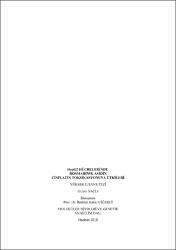| dc.contributor.advisor | Ciğerci, İbrahim Hakkı | |
| dc.contributor.author | Saçlı, Gizem | |
| dc.date.accessioned | 2019-08-06T06:25:11Z | |
| dc.date.available | 2019-08-06T06:25:11Z | |
| dc.date.issued | 2019 | en_US |
| dc.identifier.uri | https://hdl.handle.net/11630/6776 | |
| dc.description.abstract | Tıbbi bitkiler yalnızca terapötik ajan olarak değil, farmakolojik araştırmalar ve ilaç geliştirme için önemlidir. Günümüzde fitoterapiye (phytos: bitki, therapy: tedavi) ilgi artmıştır. Özellikle dermatolojik hastalıklar, enfeksiyonlar ve çeşitli kanser hastalıklarının tedavisinde fitoterapi kullanılmaktadır.
Biberiye, kekik gibi bitkilerde bulunan, doğal antioksidan olan rosmarinik asit (RA), antimikrobiyal etkiye de sahiptir. Kemoterapik ajan olan sisplatin (CisP), kanser hücrelerinde gelişimi ilerlemeyi durdurucu etki gösterirken bununla birlikte sağlıklı hücreleri de yok etmektedir. Kemoterapik ilaçlarla birlikte fitoterapik bileşikler kullanılarak antikanser etkinin arttırılması ve yan etkilerin ise azaltılması amaçlı çalışmalar yapılmaktadır. Sunulan çalışmada karaciğer karsinom hücrelerini (HepG2) kullanarak, rosmarinik asitin sisplatin toksikasyonuna etkilerini; MTT yöntemi (3-(4,5-dimetiltriazol-2-il)-2,5-difeniltetrazolium bromid), mikronükleus testi ve komet yöntemi kullanılarak araştırılmıştır. Bu amaçla RA ve CisP’nin HepG2 hücrelerinde MTT yöntemi ile sitotoksisitesi belirlendi ve farklı konsantrasyonlarda hücre canlılığı etkisine bakıldı. Sonrasında RA’in CisP ile kombinasyonunda mikronükleus testi ve komet yöntemi ile DNA hasar tespiti ile antikanser etkilerine açıklık getirilmesi incelenmiştir.
RA’in HepG2 hücrelerinde sitotoksisitesi belirlenirken kontrol grubu, 0,125 mM, 0,25 mM, 0,5 mM, 1,25 mM, 2,5 mM, 6,25 mM, 12,5 mM, 25 mM, 50 mM dozları kullanıldı. RA’in LD50 değeri 13,8 mM ve LD0 değeri ise 0,01 mM bulundu. Sitotoksisite analizi sonuçlarına göre RA konsantrasyonu arttıkça hücre canlılığı azalmıştır. CisP dozları ise 10 µg/mL, 20 µg/mL, 50 µg/mL, 100 µg/mL, 200 µg/mL, 400 µg/mL, 600 µg/mL, 800 µg/mL, 1000 µg/mL kullanıldı. Sisplatinin HepG2 hücrelerinde LD50 değeri 11,06 µg/ml olarak bulundu. RA ve CisP’e ait LD50 dozları belirlendikten sonra, HepG2 hücreleri yeterince çoğaltılarak hücrelerden 4 grup oluşturuldu. Her grupta n sayısı en az 3 olacak şekilde çalışıldı.
Gruplar; kontrol grubu, RA grubu, CisP grubu ve RA+CisP grubu şeklinde planlandı. RA’in CisP toksikasyonuna etkisi belirlenirken LD0 dozu kullanıldı. CisP ‘in ise LD50 dozu kulanıldı. Deney gruplarına uygulamalar yapıldıktan 24 saat sonra elde edilen hücreler komet ve mikronükleus testlerinde kullanıldı.
Elde edilen sonuçlar CisP’nin HepG2 hücrelerinde genotoksisiteyi artırdığını, LD0 dozunda RA’in ise CisP toksikasyonu sonucu oluşan genotoksisiteyi azaltabileceğini akla getirmektedir. Fakat bunun daha net ortaya konabilmesi için, bu tez çalışmasında yapılan uygulamaların, sağlıklı hücrelerle eş zamanlı bir şekilde tekrarlanmasının yararlı olabileceği düşünülmektedir. | en_US |
| dc.description.abstract | Medicinal plants are important not only as therapeutic agents, but also for pharmacological investigations and drug development. Today phytotherapy (phytos: plant, therapy: treatment) has increased interest. Phytotherapy is used for the treatment of dermatological diseases, infections and various cancer diseases.
Rosmarinic acid (RA), a natural antioxidant, found in many plants such as rosemary, oregano, has antimicrobial effect. The chemotherapeutic agent, cisplatin (CisP), has a progressive effect on the development of cancer cells, but it also destroys healthy cells. Chemotherapeutic drugs are used together with phytotherapeutic compounds to increase the anticancer effect and reduce cytotoxicity. In our study, the effects of rosmarinic acid on cisplatin toxicity were examined by MTT method (3-(4,5-dimetiltriazol-2-il)-2,5-difeniltetrazolium bromid), micronucleus test and comet method on liver carcinoma cells (HepG2). The cytotoxicity of RA and CisP in HepG2 cells was determined by MTT by using different concentrations. Then, RA with CisP were used in combination to evaluate the DNA damage by micronucleus test and comet method.
Different doses of RA were used, 0,125 mM, 0,25 mM, 0,5 mM, 1,25 mM, 2,5 mM, 6,25 mM, 12,5 mM, 25 mM, 50 mM on HepG2 cells along with control group for 24- hour. The LD50 value was 13,8 mM and the LD0 value was 0,01 mM. According to the MTT method results, cell viability decreased as RA concentration increased. CisP doses were 10 µg/mL, 20 µg/mL, 50 µg/mL, 100 µg/mL, 200 µg/mL, 400 µg/mL, 600 µg/mL, 800 µg/mL, 1000 µg/mL used. The LD50 value was found to be 11,06 µg/mL. After LD50 doses of RA and CisP were determined, HepG2 cells were sufficiently amplified to form 4 groups of cells. In each group, the number of n was studied at least 3. Groups; control group, RA group, CisP group and RA + CisP group. LD0 dose was used to determine the effect of RA on CisP toxicity. LD50 dose of CisP was used. 24 hours after the application to the experimental groups, the obtained cells were used in comet and micronucleus tests.
The results suggest that CisP increases genotoxicity in HepG2 cells and that LD0 dose of RA may reduce genotoxicity caused by CisP toxicity. However, in order to make this clearer, it is thought that it may be useful to repeat the applications performed in this thesis study simultaneously with healthy cells. | en_US |
| dc.language.iso | tur | en_US |
| dc.rights | info:eu-repo/semantics/openAccess | en_US |
| dc.subject | Komet Yöntemi | en_US |
| dc.subject | Sisplatin | en_US |
| dc.subject | Rosmarinik Asit | en_US |
| dc.subject | Mikronükleus Test | en_US |
| dc.subject | Hepg2 Hücreleri | en_US |
| dc.subject | MTT Test | en_US |
| dc.title | Hepg2 hücrelerinde rosmarinik asidin cisplatin toksikasyonuna etkileri | en_US |
| dc.title.alternative | The effects of rosmarinic acid on cisplatin toxicity in Hepg2 cells | en_US |
| dc.type | masterThesis | en_US |
| dc.department | Fen-Edebiyat Fakültesi | en_US |
| dc.identifier.startpage | 1 | en_US |
| dc.identifier.endpage | 62 | en_US |
| dc.relation.publicationcategory | Tez | en_US |



















